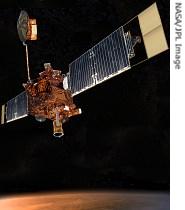2006年VOA标准英语-NASA Says Oldest Mars Satellite May be Dead(在线收听)
By David McAlary
Washington
21 November 2006
The U.S. space agency NASA says its oldest satellite orbiting Mars has probably ended its career. NASA engineers lost contact with it about three weeks ago and are losing hope of ever hearing from it again. But NASA is celebrating its accomplishments rather than mourning its apparent death.
 |
| Artist's concept of Mars Global Surveyor |
For nine years it pumped out data until November 2, when it emerged from a communications blackout behind Mars and never beamed another signal.
NASA's lead Mars exploration scientist, Michael Meyer, speaks of it reverentially.
"We may have lost a dear old friend and teacher, Mars Global Surveyor," he said. "This mission launched on November 7, 1996 has not only exceeded her design lifetime by five-fold, but it has changed our concept of the red planet."
NASA says the spacecraft may no longer be able to generate enough power to communicate. There are signs that a solar energy panel appears unable to pivot easily and track the sun. But engineers are exploring other possible reasons for the radio silence.
They are also trying to detect it through other U.S. craft at Mars. The newest Mars satellite, the Mars Reconnaissance Orbiter, pointed its cameras toward the Global Surveyor Monday, but preliminary analysis of the images shows no sightings. NASA is also employing one of its two ground rovers, the Opportunity, to try to listen for a weak signal from the silent satellite.
But the agency's Mars Program Manager, Fuk Li, says the prospects for recovery are not good.
"We are still holding out some hope, but we are fully prepared in our hearts that we may never be able to talk to the spacecraft again," noted Mr. Li. "But we are also fully prepared to celebrate the fact that it has been a job well done."
Mars Global Surveyor has operated longer than any spacecraft ever sent to the red planet. NASA cites many of its important discoveries, several of which point to clear signs that water flowed in the red planet's recent history. The agency plans to send future spacecraft to areas once covered by water in the hope of finding signs of past life.
The Global Surveyor found gullies that appear to have been cut by water in relatively modern times. It sensed a mineral called hematite that often forms under wet conditions. It found a fan-shaped area of interweaving, curved ridges interpreted as evidence of an ancient river delta. It showed that Mars' polar ice caps are made of frozen water, not frozen carbon dioxide as previously thought.
The satellite also found local magnetic fields, indicating that Mars once had a global magnetic field like Earth's, shielding it from cosmic rays. Because it worked so long, it was able to track environmental changes through many annual cycles.
"Mars Global Surveyor has generated a tremendous legacy, not only in the discoveries at hand, but also in the future scientific surprises to be discovered from the ongoing analyses," added Michael Meyer.